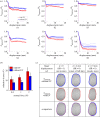Fingerpad contact evolution under electrovibration
- PMID: 31362623
- PMCID: PMC6685024
- DOI: 10.1098/rsif.2019.0166
Fingerpad contact evolution under electrovibration
Abstract
Displaying tactile feedback through a touchscreen via electrovibration has many potential applications in mobile devices, consumer electronics, home appliances and automotive industry though our knowledge and understanding of the underlying contact mechanics are very limited. An experimental study was conducted to investigate the contact evolution between the human finger and a touch screen under electrovibration using a robotic set-up and an imaging system. The results show that the effect of electrovibration is only present during full slip but not before slip. Hence, the coefficient of friction increases under electrovibration as expected during full slip, but the apparent contact area is significantly smaller during full slip when compared to that of no electrovibration condition. It is suggested that the main cause of the increase in friction during full slip is due to an increase in the real contact area and the reduction in apparent area is due to stiffening of the finger skin in the tangential direction.
Keywords: contact mechanics; electroadhesion; electrovibration; haptic perception; tactile feedback.
Conflict of interest statement
We declare we have no competing interests.
Figures




References
-
- Watanabe T, Fukui S. 1995. A method for controlling tactile sensation of surface roughness using ultrasonic vibration. In IEEE Int. Conf. Robotics and Automation, Nagoya, Japan, 21–27 May 1995 , pp. 1134–1139. (10.1109/ROBOT.1995.525433) - DOI
-
- Biet M, Giraud F, Lemaire-Semail B. 2008. Implementation of tactile feedback by modifying the perceived friction. Eur. Phys. J. Appl. Phys. 43, 123–136. (10.1051/epjap:2008093) - DOI
Publication types
MeSH terms
LinkOut - more resources
Full Text Sources

